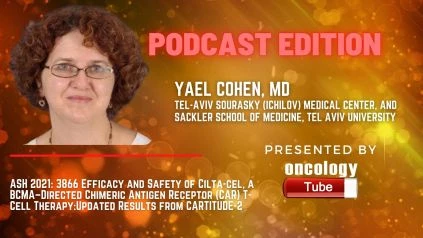Yael Cohen, MD from Tel-Aviv Sourasky (Ichilov) Medical Center, and Sackler School of Medicine, Tel Aviv University speaks about the ASH 2021 Abstract – 3866 Efficacy and Safety of Ciltacabtagene Autoleucel (Cilta-cel), a B-Cell Maturation Antigen (BCMA)–Directed Chimeric Antigen Receptor (CAR) T-Cell Therapy, in Lenalidomide-Refractory Patients with Progressive Multiple Myeloma after 1–3 Prior Lines of Therapy: Updated Results from CARTITUDE-2.
Link to Abstract:
https://ash.confex.com/ash/2021/webprogram/Paper146072.html
Introduction:
Patients with progressive multiple myeloma (MM) who are refractory to lenalidomide have numerous therapy choices, however most pts relapse quickly after getting salvage medication. In the phase 1b/2 CARTITUDE-1 research, Cilta-cel, a CAR-T treatment expressing two BCMA-targeting, single-domain antibodies, displayed early, profound, and sustained responses in patients with MM who had had three prior lines of therapy (LOT) (Berdeja, Lancet, 2021). The CARTITUDE-2 study (NCT04133636) is a multicohort, open-label, phase 2 research that is examining cilta-cel safety and efficacy in various clinical settings for patients with MM, as well as the suitability of outpatient administration. Initial analysis of patients in CARTITUDE-2 cohort A (lenalidomide-refractory with 1–3 previous LOT) revealed a 95 percent overall response rate (ORR), with 75 percent obtaining complete response or better (CR) and 85 percent achieving very good partial response or better (VGPR). We’ve updated the results for this demographic.
Methods:
Pts had progressing MM following 1–3 prior LOTs, which included a PI and an immunomodulatory drug (IMiD), were lenalidomide-refractory, and had never been exposed to BCMA-targeting drugs. After apheresis, bridging therapy was permitted. 5–7 days following the initiation of lymphodepletion (daily cyclophosphamide [300 mg/m2] and fludarabine [30 mg/m2] for 3 days), a single cilta-cel infusion (target dose 0.75106 CAR+ viable T cells/kg) was given. Minimal residual disease (MRD) negative was the primary objective, which was set at 10-5. ORR, DOR, length, and duration of MRD negative, and incidence and severity of AEs were all secondary objectives. Next-generation sequencing was used to quantify MRD, IMWG criteria were used to assess response, and CTCAEv5.0 was used to grade adverse events (AEs) (CRS and ICANS by ASTCT).
Results:
The first findings from this cohort were presented at ASCO 2021. We present data as of the data cutoff date of April 15, 2021 (median follow-up 9.7 months; range 3.3–13.4). Cilta-cel was given to 20 patients (65 percent of whom were men, with a median age of 60 years [range 38–75]) and one patient was treated in an outpatient setting. Pts had a median of two prior LOTs (range 1–3); 60% had one or two prior LOTs, and 40% had three prior LOTs. All of the patients were given a PI, IMiD, and dexamethasone, and 95 percent of them were given alkylating drugs and 65 percent were given daratumumab. In total, 95% of points were refractory to the previous LOT, with 40% being triple-class refractory. The ORR was 95 percent (95 percent CI 75.1–99.9), the CR was 85 percent (95 percent CI 62.1–96.8), and the VGPR was 95 percent (95 percent CI 75.1–99.9). (Figure). The median time to first reaction was 1.0 month (range 0.7–3.3); the median time to best response was 3.3 months (range 0.9–7.9); and the median time to complete response was 2.6 months (range 0.9–7.9). The median DOR was not attained, however the 6-month PFS rate was 90% (95 percent confidence interval: 65.6–97.4). At 10-5, 92.3 percent (95 percent CI 64.0–99.8) of MRD-evaluable pts (n=13) were MRD-negative. Neutropenia (95 percent; grade [gr] 3/4: 95 percent), thrombocytopenia (80 percent; gr 3/4: 35 percent), anemia (75 percent; gr 3/4: 45 percent), lymphopenia (65 percent; gr 3/4: 60 percent), and leukopenia (55 percent; gr 3/4: 55 percent) were the most common hematologic adverse events (AEs). CRS was found in 95% of the patients (gr 3/4: 10%). The median time from the initiation of CRS to the onset of symptoms was 7 days (range 5–9), with a median duration of 4 days (range 2–11). 90% of patients with CRS had their symptoms resolved within 7 days. CAR T-cell neurotoxicity was seen in four points (20%; all grades 1/2). Three patients (15%) had ICANS (all grade 1/2), with a median onset time of 8 days (range 7–10) and a median duration of 3 days (range 1–3). Other neurotoxicities were present in one patient (gr 2 facial paralysis), with a time to onset of 29 days and a duration of 51 days. There was no movement or neuropsychological TEAEs seen. COVID-19 has resulted in one death (assessed as treatment-related by the investigator). The patient’s safety profile was tolerable in an outpatient environment.
Conclusions:
A single cilta-cel infusion resulted in early and profound responses in pts with MM who had 1–3 previous LOT and were lenalidomide-refractory after a prolonged median follow-up of 9.7 months. The ORR in this group was similar to that seen in the CARTITUDE-1 study in strongly pretreated patients; responses intensified over time, with 92 percent of MRD-evaluable patients achieving MRD 10-5 negative. The safety profile was controllable; CRS was largely gr 1/2, and no movement or neurocognitive TEAEs were reported, indicating the success of the monitoring and patient management measures used in the CARTITUDE program’s phase 2/3 studies. Additional recruitment in this cohort is ongoing, and this pt population is being investigated further in the CARTITUDE-4 trial (NCT04181827).

